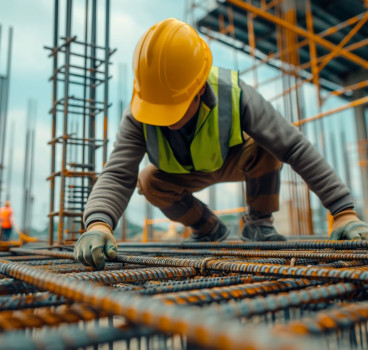How insulation innovation is reshaping construction
Insulation – the invisible barrier that helps us to save energy and to keep our buildings comfortable – is undergoing a massive transformation with the launch of new materials and techniques that will help to reshape construction writes John Ridgeway.
For decades, traditional insulation materials like fiberglass and mineral wool have dominated the scene. However, a growing focus on environmental responsibility and the need for superior performance is pushing the boundaries of insulation technology.
Traditional insulation production can be highly energy-intensive and the disposal of some materials poses challenges. Bio-based insulation solutions like hemp, cellulose, and sheep's wool now offer a greener alternative and some manufacturers are also incorporating recycled materials such as plastic bottles and glass into their products, to help reduce reliance on virgin resources, but this is just a small part of the story.
Today's insulation materials go beyond simply keeping the heat in or out. Advanced insulation solutions such as Vacuum Insulated Panels (VIPs) boast exceptional thermal performance compared to traditional options. These ultra-thin panels can potentially reduce wall thicknesses and increase usable space in buildings.
Aerogels, with their incredibly low thermal conductivity, offer another avenue for high-performance insulation. While their high cost currently limits widespread adoption, research is ongoing to make them more affordable. Another exciting development is Phase-Change Materials (PCMs). These materials have the unique ability to absorb and release heat, helping to maintain a more consistent temperature within buildings, reducing energy consumption for both heating and cooling.
The way we install insulation is also evolving. Spray-on insulation, such as spray foam, offers excellent air sealing properties and fills irregular gaps and cavities, minimising thermal bridging – a phenomenon where heat or cold can transfer through a building element due to a difference in thermal conductivity.
Continuous Insulation Systems (CIS) take a holistic approach, involving installing insulation on the exterior of the building envelope, reducing thermal bridging and improving overall building performance. With advancements in digital design and fabrication, the prefabrication of insulation panels using 3D modelling and advanced cutting techniques further allows for a perfect fit and minimises installation waste.
These advancements in insulation materials and techniques will have a significant impact on various aspects of the construction industry. Many countries are implementing stricter energy efficiency regulations for new buildings. This will drive demand for high-performance insulation materials, encouraging the construction industry to adopt advanced solutions like VIPs or thicker layers of traditional insulation to meet stricter thermal performance standards.
To incentivise the adoption of energy-efficient building practices, governments are also offering financial incentives like tax credits or rebates to builders and homeowners who use high-performance insulation solutions. This will further propel the adoption of innovative insulation products in the construction industry.
All of this will, of course, involve change. New insulation technologies might require specialised skills for installation and handling. This could necessitate training programmes for construction workers to ensure proper installation techniques that maximise the performance benefits of these advanced materials.
Architects and engineers will need to consider the unique properties of new insulation materials during the design process. Optimising wall and roof assemblies to incorporate these materials effectively, will be crucial to achieve the desired thermal performance and maximise usable space.
The rise of prefabrication and modular construction techniques also aligns perfectly with the growing adoption of prefabricated insulation panels. This streamlines the construction process, minimises on-site waste, and ensures a tight thermal envelope for energy-efficient buildings.
Building Information Modelling (BIM) allows for modelling buildings virtually, incorporating the thermal properties of different insulation materials. This enables architects and engineers to optimise insulation placement and thickness throughout the building to achieve optimal thermal performance.
The innovations in insulation technology offer a glimpse into a future where buildings are not only comfortable but also energy-efficient and environmentally responsible. High-performance insulation will significantly decrease the energy required to heat and cool buildings. This translates to lower energy bills for homeowners and businesses and most importantly, a reduced carbon footprint for the construction and building operation sectors.
Advanced insulation materials can also contribute to improved indoor air quality by minimising air leakage. This creates a healthier and more comfortable living environment. While the initial cost of some advanced insulation materials might be higher, the long-term energy savings can lead to significant cost benefits over the lifespan of a building.
Many new insulation solutions also offer superior durability compared to traditional options. This can reduce the need for maintenance or replacement over time, contributing to a more sustainable building lifecycle.
So, we can see that the future of insulation is brimming with promise. As research and development continue, we can expect even more innovative materials and techniques to emerge. Collaboration between insulation manufacturers, construction professionals, architects, and policymakers will be key to facilitating the widespread adoption of these advancements. Embracing these innovations in insulation holds the potential to transform the construction industry, paving the way for a more sustainable and energy-efficient built environment for generations to come.
Sources:
- Green Building Alliance: https://www.usgbc.org/ - Promotes sustainability in construction and provides information on eco-friendly insulation materials.
- National Resources Defense Council (NRDC) - Green Building: https://www.nrdc.org/sustainability-nrdc - Offers insights on sustainable building practices and materials, including insulation.
- North American Insulation Manufacturers Association (NAIMA): https://www.naima.org/ - NAIMA represents insulation manufacturers and offers resources on different insulation types and their applications.
- Lawrence Berkeley National Laboratory - Building Technologies Department: https://buildings.lbl.gov/ - Provides information on various insulation materials, including advanced solutions like aerogels and PCMs
- Spray Polyurethane Foam Alliance (SPFA): https://www.sprayfoam.org/ - Provides information on the benefits and applications of spray foam insulation.
- Building Envelope Institute (BEI): [invalid URL removed] - Offers resources and training on continuous insulation systems and building envelope design.
Additional Blogs

What the UK can learn from global construction tech leaders
The UK construction sector stands at a critical crossroads. Mounting pressures - stagnant productivity, acute labour shortages, tightening safety requirements, ambitious carbon-reduction targets and...
Read moreAre architects losing their influence in the digital era?
For decades, architects have been the central creative force in construction, shaping the buildings we see and the way projects are conceived, communicated and delivered. Their role has been...
Read more

Why the word “Innovation” has lost its meaning in construction
“Innovation” has become one of the most overused terms in construction. It appears in the dozens of press releases we receive each day, conference talks and project reports, often without any real...
Read more